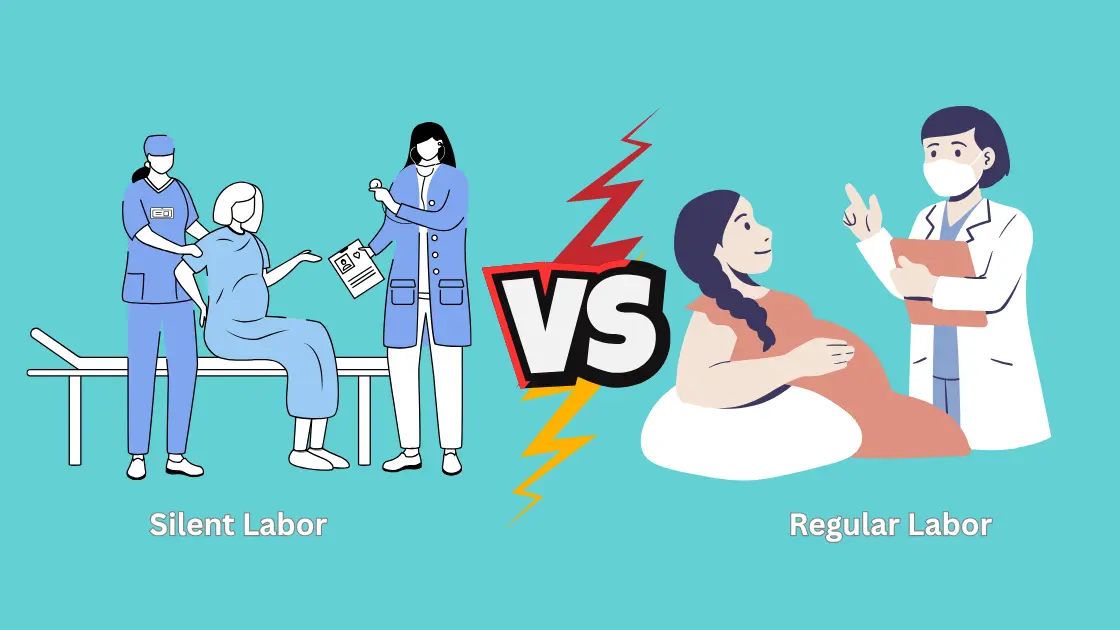When approaching the later stages of pregnancy, it is natural to be excited and anxious at the same time about the future labor. But what if labor begins without the ordinary symptoms? Silent labor signs can often go unnoticed, leaving many expecting mothers uncertain about what’s happening with their bodies.
Learning these signs can help you be more ready to expect your baby despite silences. In this case, we are going to explore the nature of these signs, how to identify them, and what you can do to deal with them.
Table of Contents
- Silent Labor Signs – What Is It?
- The Top Silent Labor Signs You Shouldn’t Ignore
- How to Identify Silent Labor in Pregnancy
- Signs of Silent Labor vs. Regular Labor
- What Are the Signs of Silent Labor?
- Why Silent Labor Happens
- How to Manage Silent Labor at Home
- Silent Labor: When to Call Your Doctor
- FAQ: Common Questions About Silent Labor
- Final Thoughts on Silent Labor Signs
Silent Labor Signs – What Is It?

Silent labor describes the slow progression that may not fit with the popular and dramatic expectation of how labor can be suffered. Even though we can all agree that when a woman goes into labor, contractions and breaking of water are the major changes that everyone notices, silent labor can have subtle signs that may indeed go unnoticed.
The Top Silent Labor Signs You Shouldn’t Ignore
Some common silent labor signs include:
· Frequent Lower Back Pain: It is common for women they have mild and persistent lower back pain, which can be confused with other problems. This pain is usually mild instead of sharp and may remain persistent or fluctuate. Frequently, this is because of the increasing weight of the baby and preparing the body to give birth.
· Tightening of the Belly: This often occurs without sharp contractions but may feel like your belly is unusually hard. It could happen intermittently or for extended periods, often mistaken for just general pregnancy discomfort. However, it’s your body’s way of preparing for labor, even if you don’t feel traditional contractions.
· Increase in Discharge: A clear, mucus-like discharge or bloody show is common in silent labor. This increase in discharge can also include slight bleeding, which may be alarming but often signals that your cervix is starting to dilate. Always notify your doctor or midwife about any changes in discharge during pregnancy.
· Subtle Cramping: Cramping that doesn’t feel like traditional contractions but still intensifies over time. The cramping can occur lower in the abdomen or the pelvic area, and although it doesn’t have the rhythm of real labor, it still indicates that the body is preparing for delivery. Sometimes this cramping is a sign of early dilation.
· Shortness of Breath: A sensation of being out of breath due to hormonal changes and pelvic pressure. As your baby grows, it can pressure your diaphragm, making it harder to take deep breaths. This feeling may come and go and can be worsened by the emotional anticipation of labor starting, contributing to a sense of anxiousness.
Noticing these may be a clue to silent labor still in progress, but these are the latent signs.
How to Identify Silent Labor in Pregnancy

One of the challenges with silent labor is that its signs can be easily overlooked or mistaken for other things. Often, these signs are so mild that you may not feel they are a cause for concern.
· Changes in the Pattern of Baby Movement: Although your baby will not be as active, a marked decrease in movement can be noted. Do not stop paying attention to the features of your children that may indicate low birth weight; mention this in case there is a significant decrease in the attending medical professional. Any decreased activity may be a warning that labor is coming, and one should pay attention to these little steps.
· Pressure in the Pelvic Area: Silent labor may cause pelvic pressure as your baby begins to descend. This may feel like the baby is dropping lower into the birth canal, but without the heavy contractions typically associated with it. The sensation of heaviness may also be accompanied by mild discomfort in the pelvic or groin area, signaling that labor is beginning.
· Feeling of Heaviness or Fullness: An odd, uncomfortable sensation of fullness could be the body’s way of preparing for labor. This may feel like pressure or tightness in your lower abdomen or pelvis, making it difficult to move comfortably. The reason that the baby is nearer to delivery means that body is adapting to the situation.
Signs of Silent Labor vs. Regular Labor

While silent labor signs can seem subtle, they are often confused with normal pregnancy discomforts. You must understand the two or else you can easily miss some major signals.
Here are the key differences:
Silent Labor Signs:
- Gradual cramping or mild discomfort is a subtle sign that your body is preparing for labor. Unlike sharp contractions, the cramping may be more of a dull ache that intensifies over time, without being particularly painful. The discomfort could feel like a heaviness in the abdomen or pelvis.
- Low energy or feeling “off”: You might feel unusually fatigued or not quite yourself. This could be due to hormonal changes or the body’s preparation for labor, signaling that something is starting to shift. Many women also experience mood swings or heightened irritability during this time.
- Changes in discharge include an increase in mucus-like discharge or a bloody show. It’s a sign that the cervix is starting to soften and open, a standard early indicator of labor, even if not accompanied by strong contractions. You may notice a slight pink or brown tint in the mucus.
Mild, irregular back pain: Silent labor can cause discomfort in the lower back that comes and goes.It’s not as intense as full labor pain but it is a sign that the body is progressing into the next stage of labor. This pain is nearly always described as a heavy sensation in the lower back, not really a sharp stabbing pain.
Regular Labor Signs:
- Strong, consistent contractions: Intense, steady contractions: These contractions become more recognizable, more frequent, and come by stronger. Unlike the uncoordinated cramping of pre-labour, these are indicative of active labour. Each contraction lasts anywhere from 30-60 seconds and gets stronger with each attempt.
- Water breaking or a gush of fluid is often a more dramatic sign of labor. When the amniotic sac ruptures, it releases fluid, signaling that the body is preparing for delivery. The fluid may gush or trickle out, signaling the start of active labor.
- Intense back pain that comes and goes: This is more severe than the mild back pain experienced during silent labor. It intensifies with each contraction and may feel like a sharp, constant pain. This pain may radiate through your lower back, making it difficult to find relief.
- A noticeable drop in energy levels: Energy levels can also decrease remarkably as work goes on. You might also experience a lot of fatigue as your body begins to prepare itself for the burst of physical demands in delivery. You usually experience emotional drainage, with the attention to work concentrated in the body.
Awareness of such slight variations is central in deciding when to go to the hospital or birthing center.
What Are the Signs of Silent Labor?

Some women experience labor in complete silence, with little to no noticeable pain. This might sound like a dream scenario, but silent labor signs can be just as significant as any other form of labor.
Here’s a breakdown of silent labor symptoms to look out for:
- Changes in Your Cervix: During silent labor, your cervix may begin to dilate and efface (thin out) without causing the usual sharp contractions. This can go unnoticed unless your healthcare provider examines your cervix during a checkup. As the cervix softens and opens, it prepares the body for labor, but this process can be gradual and relatively painless for some women.
- Subtle Abdominal Tightening: You may feel your belly tighten occasionally without realizing this is an early sign of labor. This often happens in silent labor, and many women mistake it for simple pregnancy discomfort. It can take several seconds or minutes and is usually unnoticed, yet the tightening is the uterus getting ready to go into more serious contractions in the future.
Why Silent Labor Happens

Silent labor can occur for several reasons, from your body’s natural readiness to give birth to hormonal fluctuations.
Some common causes include:
- Hormonal Shifts: The body’s release of oxytocin, the hormone responsible for labor contractions, may cause mild signs of labor even before it intensifies. These hormonal changes can gradually trigger subtle signs such as irregular cramping, lower back pain, or pelvic pressure, which may be difficult to notice initially.
- Low Pain Tolerance: Some women have a higher pain threshold, which means they experience fewer or milder sensations during labor. This can result in silent labor signs that go unnoticed, as their body’s physical response to labor isn’t as intense or noticeable as it might be for others.
- Fast Progression: Sometimes, silent labor can rapidly transition into full-blown active labor, catching the expectant mother off guard. This swift shift may lead to a sudden intensification of contractions or other symptoms, making it hard to prepare mentally for the whole labor experience.
How to Manage Silent Labor at Home

If you suspect you’re in silent labor, staying calm is essential. Here are some ways to manage:
- Rest and Hydrate: Take the time to rest and drink plenty of water to stay hydrated. Sleeping will give your body time to recover some energy, and hydrating your body will help you cope with any minor cramp or pain that you might have when labor set in.
- Monitor Your Contractions: Keep Track of Contractions: Watch any contractions, regardless of how minor they may seem. This can assist you in identifying a pattern. A contraction timer or contraction app can be used to watch frequency and intensity to place a better-educated guess on whether or not you are in labor.
- Walk Around: Gentle walking can help progress labor and relieve some discomfort. Moving around encourages the baby to shift position and helps to alleviate pressure or tightness in your body, promoting more efficient contractions.
Silent Labor: When to Call Your Doctor
Even though silent labor signs can be subtle, there are times when you should call your healthcare provider immediately. These consist of:
- If you observe any severe bleeding or the formation of large blood clots
- If you have severe discomfort, even if it’s only minor
- If the baby’s movements seem to have substantially diminished,
- If you experience severe contractions or your water breaks
To be sure everything is going as it should, always err on the side of caution and get in touch with your midwife or doctor.
FAQ: Common Questions About Silent Labor
1. Can silent labor last for days?
This silence of work may last not only a few hours but also several days as the physique slowly gears up for active labor.
2. Is silent labor dangerous?
Though conducting silent labor is safe in the majority of cases, you should keep an eye on your symptoms and pay a visit to a doctor in case of any doubts about whether your process is normal.
3. What should I do if I suspect silent labor?
When you feel like you may be working in silence, attempt to rest, get water, and monitor the changes that are occurring in your body. Your health care provider should always be consulted to evaluate the situation.
4. Can silent labor happen if it’s my first pregnancy?
Yes, silent labor can occur with first-time pregnancies, though it’s more commonly associated with second or third pregnancies.
Final Thoughts on Silent Labor Signs
Recognizing silent labor signs early on is crucial for expecting mothers. The indicators might not be very apparent; however, being cognizant and prepared can prove to be make-or-break. Considering the fact that silent labor may occur, do not ignore it; instead, visit your care provider so that your delivery is not characterized by complications. Just so you know, every pregnancy is different, and listening to your body’s cues may make birthing more confident and informed.
Explore more on Pregnancy Must –
